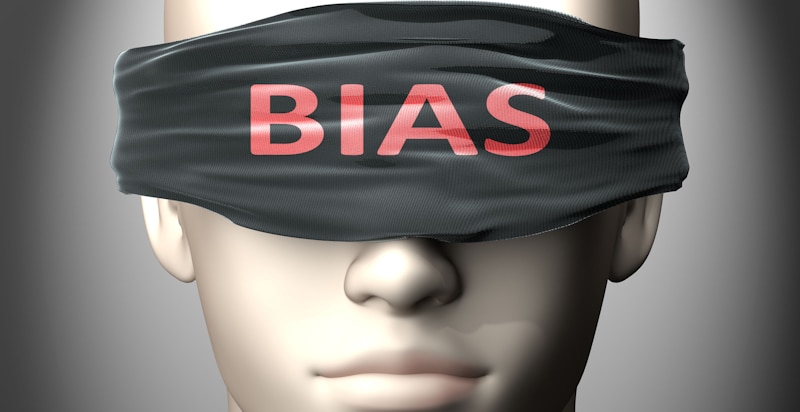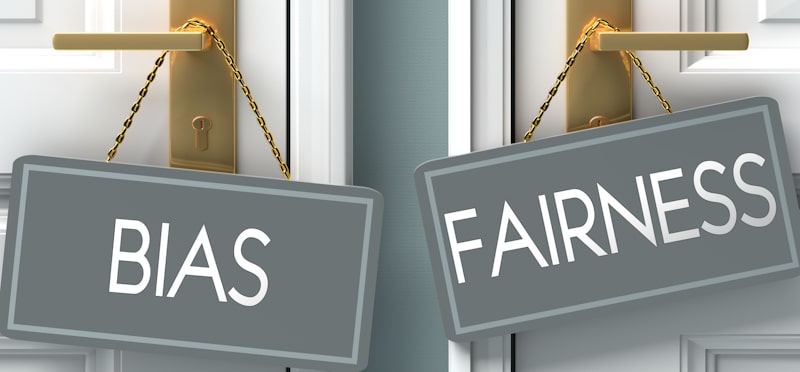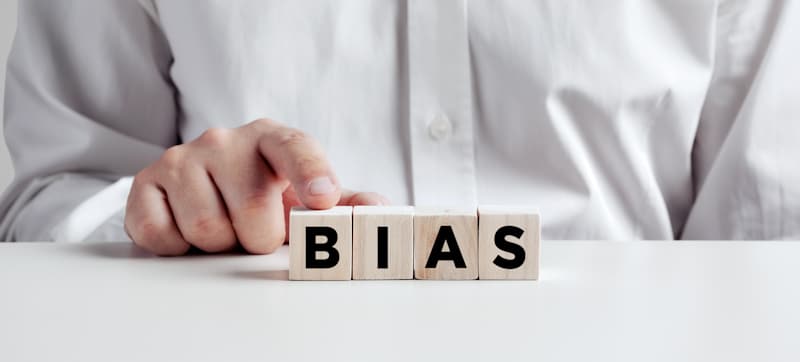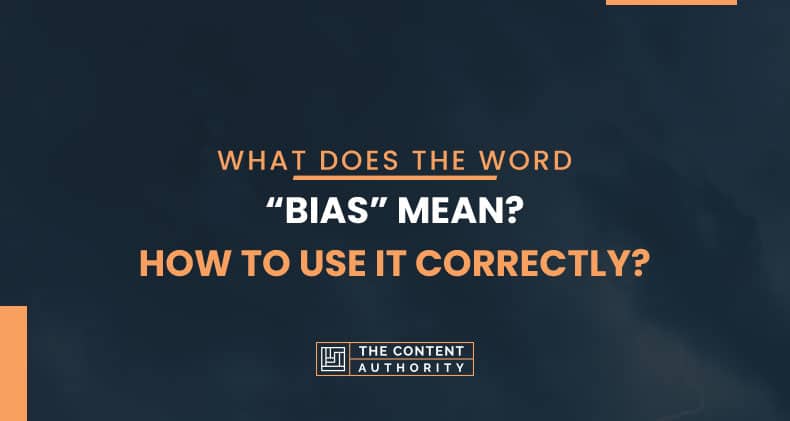There are a lot of words in the English language that sound really cool to say even if you don’t really understand what they mean. One of these words is the word “bias.” Have you ever wondered how to define this word let alone how to use it correctly in a sentence?
Bias is a word that means that someone is giving preference to one idea instead of another. For instance, you may say “Sally seems to be biased towards Italian food.” Here the word bias simply means that Sally has a strong preference for Italian food over any other type of food she may be offered.
What Bias Means
To be biased means that you are disproportionately in favor of or against an idea or a thing. Usually, this is done in such a way that you look like you’re closed-minded, prejudiced, or simply being unfair.
To gain a better understanding of the word bias you can think of it as a person who prefers an idea to the extent that they really don’t give another idea equal opportunity. There are many different factors that can influence bias. One of the biggest things that influence bias is popularity. For instance, you might say that a newspaper is biased towards a certain political party because their employees share the same political beliefs as that party.
With this understanding in mind, it’s important to note that biases can be either innate or learned. For instance, you may develop a bias for or against certain people, groups, or beliefs.
The word bias is also used in science and engineering. Here it’s referred to as a “systematic error.” This can result from taking an unfair sample of a population or from an estimation process that doesn’t provide you with results that are accurate.

Etymology of the Word “Bias”
The word “bias” comes from an Indo-European word that actually doesn’t even look as though it’s related to this word: SKER. When you look at the root of this word you’ll understand that it means to cut. In English, this gives rise to a lot of different words including:
- Shear
- Shears
- Sheer
- Score
- Scar
- Scabbard
- Scarp
- Escarpment
- Scrabble
- Scrub
- Shrub
- Scurf
- Shard
- Sharp
- Short
- Skirt
- Skirmish
- Scrimmage
- Scrum
There are also variants of this word that are related to its root, KER. These include:
- Cortex
- Decorticate
- Curt
- Cutlass
You also have the Greek adjective “karsios” which means to cut crosswise. When you add this prefix you get “epikarsios,” which also meant crosswise. However, this was used in a more restricted sense such as running at right angles. As such it was used to describe a striped garment, the planks of a ship, or the grid of streets. Sometimes this word was also used to describe coastlines. With the consonantal shift and elision, we eventually get the French word “biais,” from which comes bias.

Understanding What Bias Is
Now that you have a definition of the word, you’ll want to have a better understanding of how bias is sewn throughout the fabric of our lives. This is something that starts at a young age. People will automatically start to discriminate between those people who are like them and those who aren’t like them. While this helps children develop a sense of identity it can also result in prejudice.
There are three main types of bias:
- Information bias (a.k.a. observational bias, misclassification) occurs when there’s been an error in measuring that results in different results being obtained by different groups.
- Selection bias occurs when the selection of individuals, groups, or data that’s being analyzed is introduced in such a way that nothing is randomized. This makes it so that the sample that’s obtained doesn’t represent the population that’s being analyzed. In other words, statistical analysis has been distorted because of the way the samples were collected. If this isn’t taken into consideration the some of the study’s conclusions may not be true.
- Confounding bias is a systematic distortion that occurs in the measurement that exists between exposure and a health outcome. This is because the exposure’s effect has gotten mixed up with the extraneous risk factors.
None of these types of biases make you a bad person nor are they all negative or hurtful. However, you must recognize that bias exists or it can result in your making bad decisions in your life.
Showing Bias in Writing
When an article or an editorial is said to be biased it means that it’s showing one narrow viewpoint and excluding any other viewpoints. Oftentimes you can see that bias exists because certain facts and quotes are used in support of the favored viewpoint. If the writer decides to write their article in this fashion, then they’ll typically exclude any facts or opinions that don’t support their viewpoint. For instance, an article that shows bias towards riding a motorcycle would show facts about how riding a motorcycle will get you good gas mileage and be a lot of fun. On the other hand, if you’re writing an article that’s biased against riding a motorcycle you’ll probably show that people can get hurt and that motorcycles are noisy while you don’t say anything positive about them.
Another example would be if you were to write an article that’s biased against guns. In this article, you’d only show facts and information that support your position here. For instance, you may say that guns are responsible for suicides and accidental shootings. You may also share other facts that shed a negative light on guns. However, if you were writing an article that was in support of guns you’d only include information that shed a positive light on guns. For instance, you may state how many lives have been saved by the use of guns, how many crimes have been prevented because civilians were able to have guns and other facts and information that shed a good light on owning guns.
It’s also possible to show bias in writing by choosing to use slang words when referring to groups of people or things. Some of the most commonly used words in this regard include:
- “Broad” instead of “woman”
- “Murdercycle” instead of “motorcycle”
- “Geezer” instead of “elderly person”
- “Gypped” instead of “cheated”
- “Homo” instead of “gay person”
- “Illegal alien” instead of “immigrant”
- “Mankind” instead of “humanity”
- “Master/slave” instead of “primary/secondary”
Sometimes phrases can even be used to make assumptions, hence showing bias. For instance, someone may say that “All Chinese people are good at math.”
Additionally, bias means “a mistake in measurement.” For instance, someone may measure the height of a person while they’re wearing shoes. The shoes will make this person taller than someone who isn’t wearing shoes. If it wasn’t stated that this person was wearing shoes, then someone may think that the person is actually taller than the person who isn’t wearing shoes. This is just one of the many examples of what’s known as “biased data.”
Understanding how bias exists in our culture is important. Unfortunately, you’ll find bias in a lot of different settings – both personal and professional alike. This is something that’ll continue happening until we all have a more open mind. It’ll take some work for people to push aside their preconceived notions in this regard. What makes this worse though is that the news should be reporting stories in a way that’s completely unbiased and objective. However, this is something that doesn’t always happen in today’s culture.

Examples of How to Use Bias in a Sentence
Now that you have a better understanding of what the word bias means, you may want to start using the word in your speech. Here are a few examples of how to use this word in sentences:
- He was naturally biased regarding how things were.
- In this document, you’ll receive guidance regarding how to reduce optimism bias in scheme development.
- The people there were biased towards the French’s fashions and ways of life.
- Their self-serving bias regarding success can be illustrated by some of my own experiences.
- That’s a great way to accurately express the prevailing bias the author had.
- He showed a strong bias towards abstract thought, especially in regard to mathematics.
- This is a bias that’s been reflected in the half-truth that says “correction should precede interpretation.”
- You’ll be given a lot of details along with access to official correspondence and documents some of which will be biased but will nevertheless help you to better understand the situation at hand.
- When you compare the sovereign to her ministers you’ll find that she has the advantage of having a lot of experience in an elevated position so she isn’t nearly as biased as they are.
- Its author showed a great bias towards math and mechanics in the quantity of his units and the fact he relied heavily upon the formula.
Conclusion
Regardless of whether you come out and use the word or it’s more implicit in nature, the word bias still means the same thing: Someone is unfairly giving preference to a person, thing, or idea in comparison to another.
Shawn Manaher is the founder and CEO of The Content Authority. He’s one part content manager, one part writing ninja organizer, and two parts leader of top content creators. You don’t even want to know what he calls pancakes.

